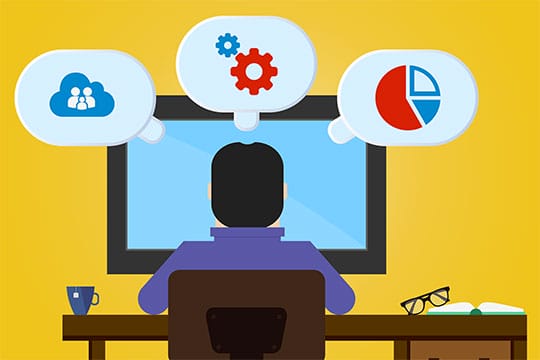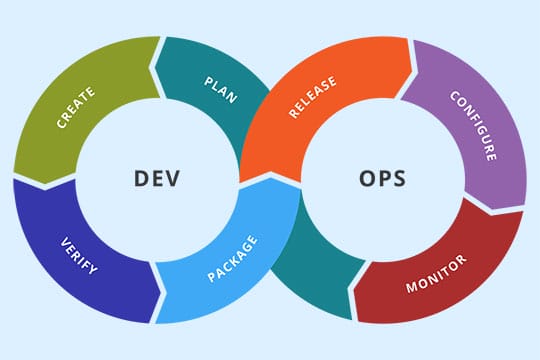DevOps is one of the newest technological trends shaping software development. Companies of all sizes are turning towards new DevOps solutions to streamline delivery, standardize customer experiences and improve cost-effectiveness. One of the primary benefits of DevOps processes is its continuous nature.
Wait, is DevOps rapidly gaining popularity?

The term DevOps became a household word in the developer community after a 2012 report by Alanna Brown. And, according to jFrog.com, a leading provider of DevOps integration tools, “Over the past seven years, DevOps adoption has accelerated considerably as the DevOps cycle is better understood; increasing the number are more nimble companies using DevOps in our 2020 outlook.” Further stating, “Every company will be a DevOps company by 2020.”
In 2015, few organizations relied on DevOps development. That figure increased by nearly 10% the following year. Between 2017 and 2018, the number of businesses adopting DevOps rose around 70%. Nearly one out of five companies took advantage of this cutting-edge technology last year. That figure is expected to rise to at least 30% within the next couple of years.
Recommended for you: How to Boost Your Sales Team's Results with Professional Reports?
What are the main factors driving growth in the DevOps industry?

The benefits of DevOps technology are becoming more evident with each passing day. They largely hinge on the continuity features that are naturally embedded into the technology and culture of the DevOps community. Here are some of the primary advantages to consider.
Continuous integration
 Continuous integration is one of the most attractive features of DevOps. Amazon Web Services provides a very straightforward definition that helps make it easier to understand.
Continuous integration is one of the most attractive features of DevOps. Amazon Web Services provides a very straightforward definition that helps make it easier to understand.
Continuous integration entails an ongoing integration process. This essentially means that developers can easily merge changes in their code into a single, centralized repository. New algorithms are regularly introduced and tests are regularly conducted.
There are a few snags in the process, which ensures a new code is regularly introduced with a few complications. Continuous integration minimizes delays and setbacks that would often come with adding in testing new code. Developers can spend a lot less time troubleshooting and transferring code to other repositories.
Continuous delivery
 Continuous delivery is a core feature of DevOps technology. However, DevOps expert Michael Schmidt makes a point of emphasizing that the two terms should not be used interchangeably. They are highly related technologies, but continuous delivery can be implemented independently of DevOps. Nevertheless, continuous delivery is a major feature of DevOps.
Continuous delivery is a core feature of DevOps technology. However, DevOps expert Michael Schmidt makes a point of emphasizing that the two terms should not be used interchangeably. They are highly related technologies, but continuous delivery can be implemented independently of DevOps. Nevertheless, continuous delivery is a major feature of DevOps.
Continuous delivery is a development concept that is predicated on incremental improvements. It is a highly effective practice for debugging software and making necessary updates.
Some of the benefits of continuous delivery include the following:
- It is easier to scale deliveries.
- Failure risks can be significantly decreased during the production process.
- The need to develop code manually is drastically reduced.
- The team has a lot more confidence in the quality of the final product.
- Automation is much easier to handle.
- Developers can receive feedback from customers and other development team members much more easily.
- Continuous delivery is vital to the DevOps process.
Establishing the framework for a DevOps continuity model

As outlined above, the benefits of continuous features in DevOps are numerous. However, appreciating those benefits won’t do much good for teams that don’t know how to leverage them. Developers that are new to the DevOps process need to know how to execute it properly. Here are some of the core fundamentals.
Create a culture built around continuous improvement

Continuous integration and delivery are both novel forms of technology that were confined to the realms of science fiction only a decade ago. Today, they are the basis of the entire concept of DevOps.
However, understanding the technical aspects alone is not enough. Developers need to actively construct a series of processes based on continuous improvement. They need to make sure that it is firmly impregnated into the cultural mindset of every person on their team.
You may like: The Big Six of an eCommerce Team – Who You Need to Hire and Why?
Introduce continuous elements at the beginning of the project

Both beginning and experienced developers often underestimate the challenges they face trying to implement large scale changes. They need to think of their projects the same way they would if it was a physical infrastructure, such as a building. It is very difficult to make major infrastructure changes to a building after it has already been constructed. It’s much easier to incorporate those elements during the initial design and construction phase.
The same principle holds with DevOps. Adding containers can make continuous integration a lot easier. However, it is much more difficult to add those containers to an existing set of algorithms. DevOps projects need to be built with these principles in mind from the very beginning. It is not impossible to make changes later, but it will be exponentially more difficult and resource-intensive.
Implementing DevOps

Once you establish the framework for a DevOps continuity model, you need to implement it. This is one of the most difficult challenges for development teams as they shift toward a DevOps culture. The major shift can cause developers to grow frustrated. This undermines the focus of the transformation. You want to use continuous processes to enforce collaboration, not push team members further apart. Start using continuous processes effectively by learning how to implement DevOps the right way.
Establish A Shared DevOps Environment

Begin implementing DevOps by establishing a shared DevOps environment. This first step sets your team up for easy collaboration. Reach out to all departments involved in business operations. These usually include development teams, testing teams, and design teams. Place everyone in one shared location. Explain that these teams will work together to achieve one common goal. Encourage them to use the new environment to learn about the tasks each team handles. With a good shared DevOps environment in place, you can use continuous processes effectively.
Invest In Quality DevOps Tools

After you establish a shared environment for teams, invest in quality DevOps tools. Your tools will directly impact the success of your implementation process. You need tools for deployment, testing, and monitoring. The top tools offer a variety of DevOps-supporting features. These features include seamless integration with DevOps pipeline, fast data verification, and full audit trails. Depending on the size of your organization, you can choose tools based on programming compatibility or integration availability. Of course, programs like Docker will allow you to store images and repositories in containers to access for everyone in the organization. This can significantly increase the speed of development and contribute to your DevOps toolchain orchestration. Keep these features in mind as you select tools for implementing DevOps continuous processes.
Reinforce A Non-Blame Culture

Next, reinforce a non-blame culture during the DevOps implementation process. With a non-blame culture, you can convince teams to work together easily. When team members make mistakes, they already feel like they let their team down. They do not respond well when their colleagues actively blame them for project failures. Blame cultures often create mistrustful cultures. Since mistrustful work environments do not promote collaboration or efficiency, you need to prevent it at all costs. Rather than blaming human error, point out that a set of actions made the most sense at the time. This way, the team can focus on creating a solution moving forward without getting too personal about who caused a particular failure. Explain the benefits of maintaining a non-blame culture so you can implement DevOps seamlessly.
Create Tailored Workshops for Each Team

The following step to implementing DevOps entails creating tailored workshops for each team. Start by first designating certain tools for individual teams. Introduce these tools to each group on their own. That way, they can get used to specific tools without feeling the pressure from other employees. Moreover, you can train workers more easily in small groups. Encourage team members to ask questions during training sessions. They will feel more confident in starting conversations when in smaller groups. Use this best practice to start benefiting from DevOps continuous processes quickly.
You may also like: Flow-e Review: A Visual Task-Board for Gmail and Office365.
Track Progress with Key Metrics

Finally, track your DevOps team’s progress with key metrics. As in any new process, measuring success is crucial. You need to know how well your team is performing in order to assist them in achieving their goals. When you can detect a problem quickly, you can also fix it quickly. Choose the right metrics to track so that you can easily identify big issues. These metrics change depending on the team. However, they all directly align with team goals. You will need to develop the right analytical skills to draw insights from the data. Measure metrics and set benchmarks to meet your development goals and objectives. Track your progress as you implement DevOps. Then, you can start making strides with continuous processes fast.
Successful organizations use DevOps to improve their end-to-end innovations. These companies benefit from DevOps solutions because they have a continuous nature. You can also benefit once you understand how DevOps is growing in various industries. To take advantage of the type of growth, establish the framework for a DevOps continuity model. Then, implement DevOps processes with a proper environment, tools, training, and culture for deployment. Follow these steps to advance with the continuous processes that serve as the foundation of DevOps.





